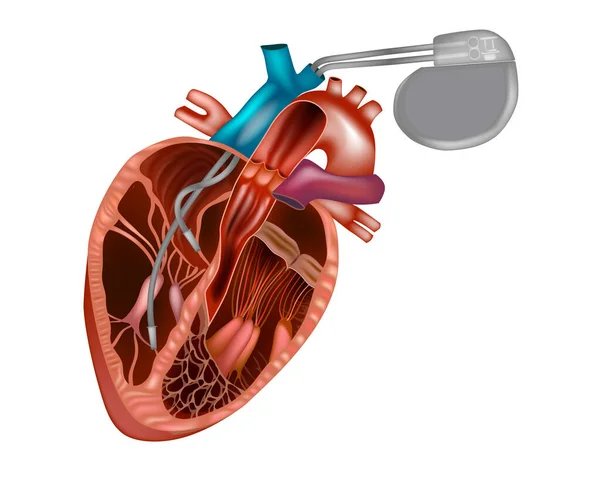Procedures
Implantable Cardiac Devices (Pacemaker, Defibrillator, Loop Recorder)
Implantable cardiac devices perform a range of functions including pacing the heart, monitoring for dangerous heart rhythms and in some cases delivering therapies (shock or pacing to treat dangerous heart rhythms). In our practice, cardiac device implantation is performed by A/Professor William Chik, who is a highly experienced operator and is accredited for device implantation at Westmead Public and Private Hospitals, Macquarie University Hospital and the Mater Hospital; all sites use advanced imaging and state-of-the-art equipment and technology to ensure the highest level of safety and procedural success. In all cases, we strive to provide the highest level of care and expertise to ensure that your device implantation procedure is safe, effective, and successful.
Pacemaker Implantation
At Auburn Cardiology Centre, we offer pacemaker implantation services for patients who require this life-saving treatment for heart rhythm problems or conditions that affect their heart’s electrical system. These conditions can cause a slow or irregular heartbeat, which can lead to symptoms such as fatigue, dizziness, and shortness of breath. A pacemaker can help alleviate these symptoms and improve your overall heart health. Pacemaker implantation is a safe and effective procedure that helps regulate the heartbeat and improve quality of life for those with heart-related issues.
During the pacemaker implantation procedure, a small device will be implemented under the skin of your chest that delivers electrical impulses to your heart. This device is connected to wires, which are threaded through a vein to your heart. The pacemaker continuously monitors your heart’s rhythm and sends electrical signals when needed to regulate the heartbeat.

Call for Appointment
(02) 9646 4044
Procedures Expertise
Coronary Angiography & Stenting
Electrophysiology Study and Catheter Ablation
Everything you need to know about
Pacemaker implantation
What is a Pacemaker?
A permanent pacemaker is a small implantable device, which sits under the skin of your chest wall and is typically used to treat abnormally slow heart rhythms called “bradyarrhythmias”. Bradyarrhythmias can cause symptoms such as dizziness, dyspnoea, fatigue and faints.
A special pacing device (Cardiac resynchronization therapy) can also be considered in some patients with heart failure to improve heart muscle function, reduce heart failure symptoms and increase survival. A pacemaker system consists of two parts:
1. A Pulse generator, which is the computerised part running on a small battery that sends small amounts of electrical energy to your heart via pPacemaker leads. The generator is placed under the skin of your chest wall.
2. Pacemaker leads, which are thin insulated wires that send electrical signals between the device and the heart.
The pacemaker is constantly monitoring and adjusting treatments to meet your body’s needs, whether you are at rest, doing regular activities or exercising. You usually do not feel the pacemaker when it is regulating your heart.
How long does the procedure take and how is a pacemaker implanted?
Pacemaker implantation is a minimally invasive procedure that typically takes between 1-2 hours to complete.
Pacemaker implantation is done under local anaesthesia, and the small device is implanted under the skin of the chest, with wires threaded through a vein to the heart. The device is inserted in a pocket of skin and the wound is closed with a waterproof dressing. The pacemaker continuously monitors the heart’s rhythm and sends electrical signals when needed to regulate the heartbeat.
Leadless pacemakers are a new pacing device directly implanted into the heart via the vein in the leg and may be considered in some cases. The use of conscious sedation or general anaesthesia will be decided on a case-by-case basis.
What are the risks associated with pacemaker implantation?
Pacemaker implantation is generally safe, but like any medical procedure, it may carry some risks based on the patient’s condition. However, serious complications are rare, and we take all necessary precautions to ensure a successful procedure.
What is the recovery time for pacemaker implantation?
Recovery time for pacemaker implantation is generally quick, and most patients are able to resume their normal activities within just a few days to a week after the procedure.
You will likely need to stay in the hospital for observation for a day or two after the procedure, but your cardiologist will provide specific instructions based on your individual case.
What care needs to be taken after pacemaker implantation?
Most patients are able to resume their normal activities within a few days of pacemaker implantation, but may need to avoid certain physical activities for several weeks to allow the incision site to heal.
How long will my pacemaker last, and what should I expect after the procedure?
The lifespan of a pacemaker varies depending on the individual case and the type of pacemaker implanted. However, most pacemakers last between 8-10 years on average before needing to be replaced.
We will test your pacemaker function at regular intervals after implantation at Auburn Cardiology Our cardiologists will provide specific instructions on how to care for the implantation site and when to follow up for further evaluation.
Call for Appointment
(02) 9646 4044
Procedures Expertise
Coronary Angiography & Stenting
Electrophysiology Study and Catheter Ablation
Book an Appointment
Call for appointment/GP referral
(02) 9646 4044
